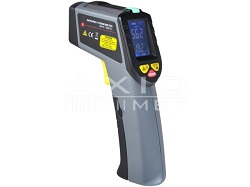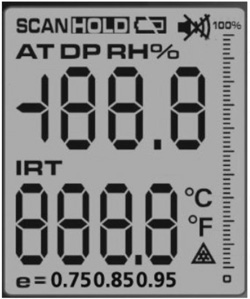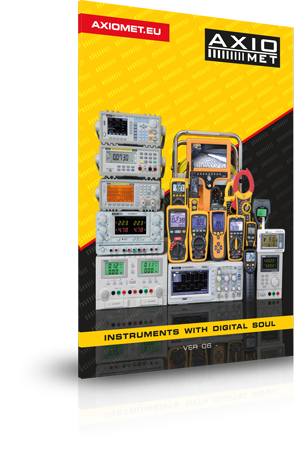Pyrometer AX-7600 - non-contact temperature and dew point measurement
AX-7600 compact pyrometer is an instrument for non-contact measurement of humidity and temperature of objects in motion, difficult to reach or dangerous to the touch, as well as for monitoring the risk of mildew formation.**
Temperature measurement is helpful in monitoring the operating parameters of equipment and initial detection of faults, where a high temperature may often be the first and easiest symptom heralding a failure or damage.
The operating principle of pyrometers is based on the measurement of the amount of thermal radiation emitted by the test object and processing it into a temperature value. The processed value is then presented directly on the device display. The primary advantage of using the non-contact measurement method - infrared (IR) is the lack of influence on the temperature of the test object.
The pyrometer offered has a broad range of temperature measurement for facility surfaces or surroundings ranging from - 50°C to + 350°C with an accuracy of ± 3°C for temperatures below 0°C and ± 2°C for temperatures above 0°C, which allows unlimited use of the device.
AX-7600 Pyrometer provides high measurement accuracy and a range of measurement functions. It has an adjustable emissivity coefficient, due to which it properly performs temperature measurements of wooden and metal facilities (in particular; glossy) with low emissivity.
| Material | Thermal emissivity | Material | Thermal emissivity |
|---|---|---|---|
| Asphalt | 0.90 to 0.98 | Material (black) | 0.98 |
| Concrete | 0.94 | Human skin | 0.98 |
| Cement | 0.96 | Skin | 0.75 to 0.80 |
| Sand | 0.90 | Coal (ash) | 0.96 |
| Earth | 0.92 to 0.96 | Varnish | 0.80 do 0.95 |
| Water | 0.92 to 0.96 | Varnish (matt) | 0.97 |
| Ice | 0.96 to 0.98 | Rubber (black) | 0.94 |
| Snow | 0.83 | Plastic | 0.85 to 0.95 |
| Glass | 0.90 to 0.95 | Wood | 0.90 |
| Ceramics | 0.90 to 0.94 | Paper | 0.70 do 0.94 |
| Marble | 0.94 | Chromium oxide | 0.81 |
| Plaster | 0.80 do 0.90 | Copper oxide | 0.78 |
| Mortar | 0.89 to 0.91 | Iron Oxide | 0.78 to 0.82 |
| Brick | 0.93 to 0.96 | Fabric | 0.90 |
The attached table helps you to apply the correct emissivity coefficient for the test object and to obtain precise measurement results.
 The AX-7600 model has a built-in relative humidity hygrometer range from 10% to 90% of measurement accuracy ± 4% for moisture content of less than 20% and ± 2% for relative humidity above 60%.
The AX-7600 model has a built-in relative humidity hygrometer range from 10% to 90% of measurement accuracy ± 4% for moisture content of less than 20% and ± 2% for relative humidity above 60%.
The distinguishing feature of AX-7600 pyrometers is the ability to determine the dew point temperature at which water vapour condensation occurs under given conditions. It measures the current room temperature and air humidity by remote sensing (non-contact). And on the basis of these values, it calculates the dew point. If the surface temperature of the object in a certain place is equal to or lower than the dew point, steam condenses on it. This measurement allows thus to locate incorrect insulation or places conducive to growth of mildew.
 The AX-7600 Pyrometer is a multifunctional device distinguished by a simple and intuitive operation via clearly described buttons and a clear display comprising of two numerical data display lines.
The display change function MODE allows you to select the appropriate parameters: dew point temperature, ambient temperature or air humidity, as well as the temperature measured using an IR sensor.
The AX-7600 Pyrometer is a multifunctional device distinguished by a simple and intuitive operation via clearly described buttons and a clear display comprising of two numerical data display lines.
The display change function MODE allows you to select the appropriate parameters: dew point temperature, ambient temperature or air humidity, as well as the temperature measured using an IR sensor.
The corresponding button allows you to enable and disable the backlight and laser sighting (cue point measurement field).
In addition, information about the actual threat of formation of mildew is presented in the form of luminous LED diodes and a sound signal in the event of a real threat (with mute function).
Power supply by a 9V battery provides up to 6 hours of continuous operation. Automatic shutdown of the device in the event of inactivity occurs after a minute. The pyrometer can operate in ambient temperatures from -10°C to 40°C. The device weight without the battery is 168g.
Examples of areas for measuring temperature using pyrometers:
- industries that require sterile facilities (food, medical, pharmaceutical);
- the construction industry in conjunction with the measurement of air temperature and humidity, warning of the possibility of condensation of water vapour on the tested facility, e.g. 'cold wall';
- diagnostics of moving and rotating machine and device components;
- diagnostics of objects connected to a live-line or in an environment containing corrosive or hazardous substances;
- diagnostics and surveillance of museum facilities and specially protected facilities;
- diagnostics of facilities of low thermal mass and/or dynamic changes in temperature.













